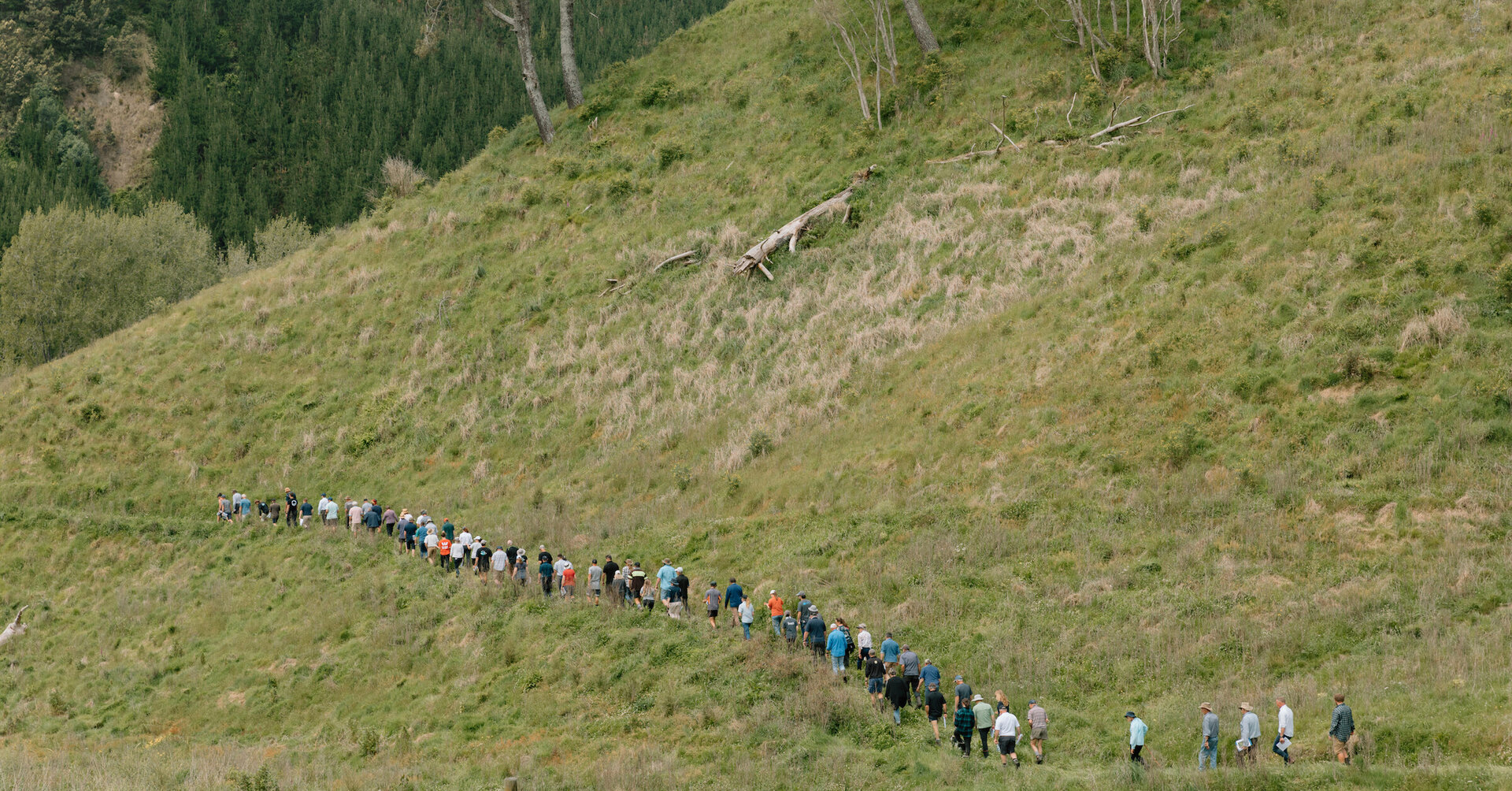2023 in Review
This has been a challenging year, starting with cyclonic events which impacted communities, farms, forestry and other land activities.
These events also showed how vulnerable our infrastructure is, particularly in remote communities that lost roading and power for extended periods. As we head into 2024, many of these matters are still being worked on.
Wai Kōkopu was impacted in a minor way by having to delay our AGM. But many of the farms in our catchment had significant flooding and consequential loss of income. In addition, with further pressures on agricultural, horticultural and forestry prices, it has squeezed our farming community with farmers also having to meet higher levels of compliance around their on-farm impacts.
That’s where Wai Kōkopu can have a significant impact with farmers, largely through our lighthouse farmers providing a ‘beacon’ of insight into farm practices to show that it’s about farming smarter, not harder. There is what I would term a reciprocity of outcomes. By having the information and advice to farm smarter, it is possible for farmers to have high farm outcomes without having to further degrade the environment.
A great example of this in action was a field day held at one of our lighthouse farms in November which was attended by around 85 people. Hosts Ann and Will Nettleingham’s dairy and dry stock unit has undergone a major transformation over the past few years. They have successfully lowered their farm’s environmental footprint while being strongly economically viable. They were milking twice a day, with over two cows per hectare. Over the years the stocking rate increased and an unplanned move to once-a-day milking in springtime prompted them to re-evaluate the farm operation and take a more holistic view of how they could continue in a more sustainable operation.
Wai Kōkopu supported them on their journey to assess their farm operations. Their farm is in a particularly sensitive part of a vulnerable catchment, alongside the Pongakawa River – one of three that flow into the Waihi Estuary. With about a quarter of their farm on steep land classed as sensitive class six, they noted the benefits of retiring that country and just focusing on the higher quality top and valley country for milking. By limiting their milking platform to probably about two-thirds of the area, they were able to generate great returns while being easier on their stock. And at the same time, retire the most vulnerable land which was going to help the estuary and the Pongakawa River. The Nettleinghams have successfully shown the value of how a more sustainable approach to farming can provide multiple benefits to farm and environmental outcomes.
While Wai Kōkopu has been around for a relatively short time, its kaupapa pervades an intergenerational approach to looking after our environment while sustaining rural communities. This is also reflected by many other “flax roots” initiatives in other rural communities through their own catchment groups.
Wai Kōkopu is a supporter of the country’s growing community-led catchment movement. Together, catchment initiatives are advancing environmental outcomes including water quality, biodiversity and climate change mitigations, while looking to sustain rural communities. These groups are successfully working with farmers where regulations are not working, and are looking to support the rural sector on current and future initiatives to maintain farming viability while working with farmers to improve their environmental outcomes.
At our November AGM, I noted a well-known whakatauki which is “tiakina te whenua o ō tūpuna”. This is literally a command to “care for the land of your ancestors”. It explains that we have a responsibility for our land and environment and that this is not an optional responsibility, but rather a birthright obligation. All of us want to leave our environment better or certainly no worse than we found it! Three people that have reflected that approach are retiring Wai Kōkopu board members Andre Hickson, John Burke and Ross Bawden who have been strong supporters of improving the footprint of agricultural and horticultural operations in our catchment. While we have lost three great members, the board is pleased to welcome new member Paul Hickson.
In reflecting on the work of Wai Kōkopu over the past year, I would like to pay tribute to the energy and commitment of our farmers and the community, our funders MPI, BayTrust and TECT, and our dedicated operational team who have worked together for common outcomes.
However, we have some big challenges. We need to be closer to our communities. We need to have more farmers and horticulturalists engaged in our plans and programmes and we need to continue to listen to our community.
Our vision is restoring the life-giving properties of Te Waihī Estuary through connected and collective action and our mission is “working together over the next 20 years to restore and replenish the Waihī Estuary; Pongakawa, Kaikōkopu and Wharere rivers and surrounding lands, contributing waters and associated biodiversity.”
Over the past year we have continued focussing on our goals of reducing sedimentation, reducing total nitrogen (by 66%), reducing phosphorus (by 30%) and bringing E. coli down by at least 50%. We have been doing this by:
Having pilot farmer environmental plans on a range of lighthouse farms to demonstrate innovative farming approaches that have a low impact on the environment.
Developing a digital pan-sector land environment plan for farms.
Working alongside primary sector groups (dairy, pastoral, forestry, horticulture) to develop land environment plan templates that meet both customer specific Global GAP standards and National Environmental Standards for freshwater.
Encouraging rapid uptake by commercial land users to develop and implement land environment plans.
Supporting detainment bunds and planting in the upper catchment area.
Where we can, supporting ongoing estuarine rehabilitation.
Planting riparian corridors and establishing wetlands and ngāhere (forest) restoration.
Facilitating access to funding, know-how and services to carry out the above work.
Connecting landowners, hau kāinga, sector groups, volunteers and communities to our projects, our learnings and to each other.
Looking to foster active, connected and engaged communities.
Facilitating the transfer of knowledge.
Supporting landowners to make on-site improvements.
Our focus is to continue assisting farmers to gather the right information to prepare land and environment plans, and to help with farm system and land use change including erodible steep land retirement, wetland planting and riparian restoration. To enable greater connection with our community, we are also focusing on educational outreach and associated work. Pest and weed control also remain an important focus area and we look to continue to collaborate with BoPRC, iwi, industry groups and research organisations (e.g. GNS with the water monitoring programme).
In addition to the work with lighthouse farms over the past year, there has been a lot of on-ground work on fish passage remediation with a KPI to have 105 sites remediated. At this stage we have looked at 374 sites, identified 116 barriers and remediated 72 of these, leaving 44 still to be remediated. Note that this is only for private property and not road sides.
One of our long-term goals is to have 450ha of land retired (note 150ha in year 2023/24) and planted, with ongoing pest and weed control. Maintenance of our 2023 plantings is ongoing and largely centred around weed control, as warm and wet spring conditions have prevailed.
Key elements of this work over the past year have been:
Early growth and establishment have been good and animal pest and noxious weed control efforts are ongoing.
Wai Kōkopu signage has now be placed on most partner properties and our team continue to build landowner relationships.
Ongoing work with landowners around retirement, planting and restoration of vulnerable catchment lands.
Over the past year we also continued our active communications programme on LinkedIn, Facebook, website updates and through our newsletter and work with local and rural media to promote our initiatives. These activities have provided great exposure for our work.
Change can only happen with a commitment by all involved. It is not easy and if it was, it would have likely already happened. The issues and opportunities are difficult and we have scarce resources to influence people around changes. But I really want to acknowledge our lighthouse famers who have made major commitments to improving the mauri of the catchment and have been happy to share their journey with the wider community. Farming is challenging and it’s often hard enough to keep farming year to year. However, we know that changes are required and these will have significant long-term benefits for overall farm environments, financial sustainability and catchment health.
Reflecting on the successes of 2023 provides an opportunity to build on the programme for 2024. Our team have developed a fantastic one day seminar to be held in March. It is titled “Our Choice: Better Farming, Better Business, Better Future.” The purpose of the day is to demonstrate the myriad ways in which farmers can proactively build better businesses for themselves and enhance te taiao.
Thanks for your support in 2023. We are always happy to take constructive feedback on what we can do better in 2024.
Nga mihi nui,
Deryck Shaw



